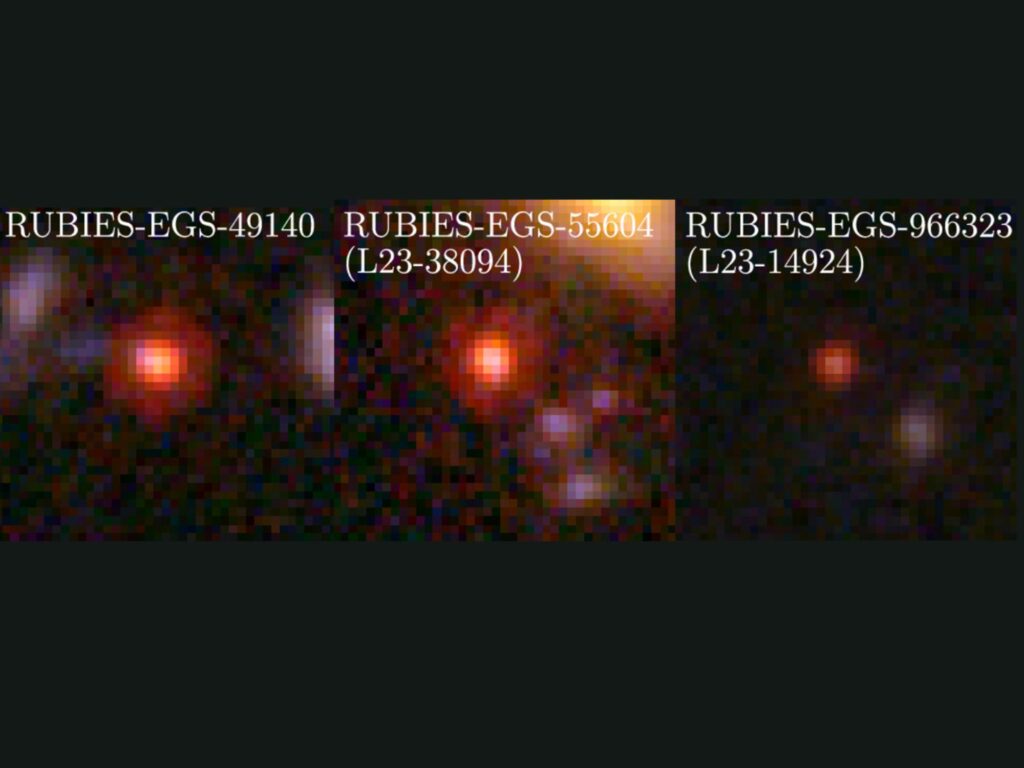Researchers at Penn State, utilizing NASA’s James Webb Space Telescope, have identified ancient, densely packed galaxies with massive black holes in the early universe, challenging current models of galaxy and supermassive black hole evolution.
An international team of scientists led by researchers at Penn State University has made a groundbreaking discovery that challenges conventional theories about the formation and evolution of galaxies and their supermassive black holes. Using NASA’s James Webb Space Telescope (JWST), the team identified three extraordinarily compact and luminous objects in the early universe, dating back only 600-800 million years after the Big Bang. This surprising find was published on June 27 in Astrophysical Journal Letters.
These objects, dubbed “little red dots” by researchers, revealed signatures of ancient stars and massive black holes far beyond what existing models predict for such an early stage of the universe’s evolution. The findings suggest that these early galaxies and their massive black holes may have grown at an unexpectedly rapid rate, posing new questions about their origins.

Credit: Bingjie Wang/Penn State and JWST/NIRSpec.
“We have confirmed that these appear to be packed with ancient stars — hundreds of millions of years old — in a universe that is only 600-800 million years old. Remarkably, these objects hold the record for the earliest signatures of old starlight,” Bingjie Wang, a postdoctoral scholar at Penn State and lead author of the study, said in a news release. “It was totally unexpected to find old stars in a very young universe. The standard models of cosmology and galaxy formation have been incredibly successful, yet, these luminous objects do not quite fit comfortably into those theories.”
The initial discovery was made in July 2022, following the release of early data from JWST. Subsequent spectral analysis of the light emitted by these objects revealed that they harbored supermassive black holes, estimated to be 100 to 1,000 times more massive than the one in the Milky Way. This finding starkly contrasts current models which assume galaxies and their black holes grow together over billions of years.
“It’s very confusing,” Joel Leja, assistant professor of astronomy and astrophysics at Penn State and a co-author of both studies, said in the news release. “You can make this uncomfortably fit in our current model of the universe, but only if we evoke some exotic, insanely rapid formation at the beginning of time. This is, without a doubt, the most peculiar and interesting set of objects I’ve seen in my career.”
The compact size of these systems — only a few hundred light years across — contrasts greatly with their enormous star populations, which range between 10 billion and 1 trillion stars. This density far surpasses that of the Milky Way, indicating unprecedented conditions and star formation rates in the early universe.
“These early galaxies would be so dense with stars — stars that must have formed in a way we’ve never seen, under conditions we would never expect during a period in which we’d never expect to see them,” Leja added. “And for whatever reason, the universe stopped making objects like these after just a couple of billion years. They are unique to the early universe.”
The revolutionary capabilities of JWST, particularly its infrared-sensing instruments, have enabled scientists to peer back to around 13.5 billion years, providing insights into the universe’s nascent stages. However, differentiating between light from stars and supermassive black holes remains a significant challenge, leaving much to be discovered about these unique objects.
“Distinguishing between light from material falling into a black hole and light emitted from stars in these tiny, distant objects is challenging. That inability to tell the difference in the current dataset leaves ample room for interpretation of these intriguing objects. Honestly, it’s thrilling to have so much of this mystery left to figure out,” added Wang.
The research team aims to conduct further observations to help untangle the enigmatic properties of these early galaxies, employing deeper spectra to isolate the contributions from stars and black holes.
“There’s another way that we could have a breakthrough, and that’s just the right idea,” Leja added. “We have all these puzzle pieces, and they only fit if we ignore the fact that some of them are breaking. This problem is amenable to a stroke of genius that has so far eluded us, all of our collaborators and the entire scientific community.”
Supported by NASA’s General Observers program and the International Space Science Institute in Bern, this research showcases the unparalleled potential of JWST in unraveling the cosmos’ earliest mysteries. As scientists continue to analyze these unexpected findings, the universe’s infancy becomes an ever more fascinating period of study.

